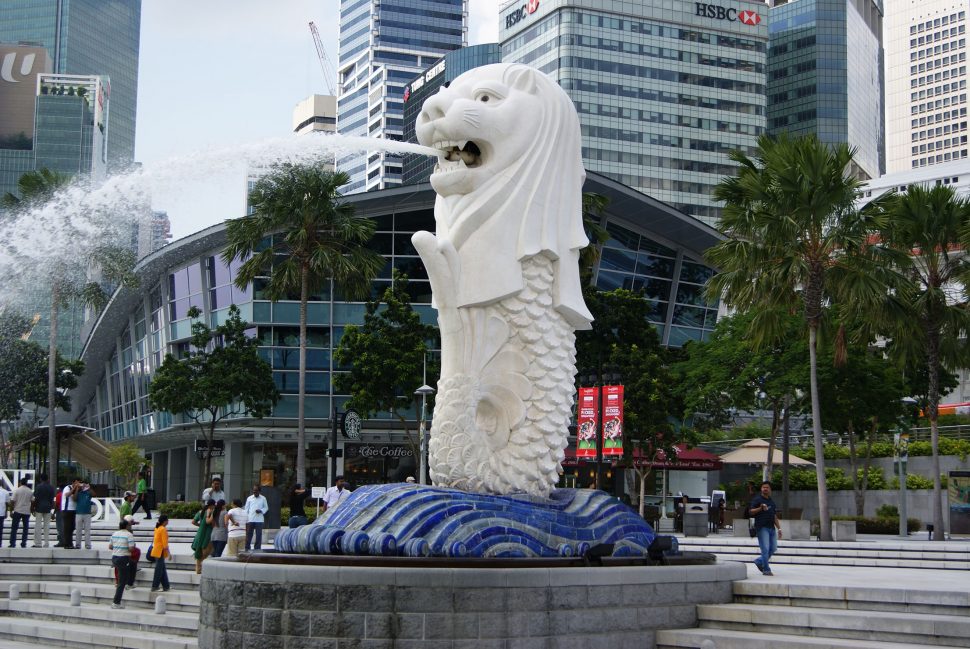(For Maurice Baker)
I have sailed many waters,
Skirted islands of fire,
Contended with Circe
Who loved the squeal of pigs;
Passed Scylla and Charybdis
To seven years with Calypso,
Heaved in battle against the gods.
Beneath it all
I kept faith with Ithaca, travelled,
Travelled and travelled,
Suffering much, enjoying a little;
Met strange people singing
New myths, made myths myself.
But this lion of the sea
Salt-maned, scaly, wondrous of tail,
Touched with power, insistent
On this brief promontory . . .
Puzzles.
Nothing, nothing in my days
Foreshadowed this
Half-beast, half fish,
This powerful creature of land and sea.
Peoples settled here,
Brought to this island
The bounty of these seas,
Built towers topless as Ilium’s.
They make, they serve,
They buy, they sell.
Despite unequal ways,
Together they mutate,
Explore the edges of harmony,
Search for a centre;
Have changed their gods,
Kept some memory of their race
In prayer, laughter, the way
Their women dress and greet.
They hold the bright, the beautiful,
Good ancestral dreams
Within new visions,
So shining, urgent,
Full of what is now.
Perhaps having dealt in things,
Surfeited on them,
Their spirits yearn again for images,
Adding to the dragon, phoenix,
Garuda, naga, those horses of the sun,
This lion of the sea,
This image of themselves.
Edwin Thumboo
Literary critic, anthologist and editor Victor Ramraj introduces us to a wide variety of world writing in his invaluable collection, Voices – actually its full title is Concert of Voices: An Anthology of World Writing in English, published by Broadview Press in Canada in 1995. Indeed, the considerable volume can give us truly useful glimpses of the literature of the world, since it crosses several boundaries, continents, languages and contemporary time periods.
An excellent example of this breadth is the introduction to the poetry of Singapore through a single work – a poem by Edwin Thumboo (b. 1933). The poem itself, “Ulysses at the Merlion”, reflects the world, echoes other world literatures, while immortalising its own environment.
Thumboo is a major writer and influence on the literature of Singapore, perhaps its most important poet. Born to a Tamil father and Chinese mother, he is sometimes described as the unofficial poet laureate of Singapore and the pioneer of its local poetry. He is an academic, a literary critic and a lecturer in English (now Professor Emeritus) at the University of Singapore, where he also served as Dean of Faculty and Head of Department.
This poem reflects his deep interest in mythology, as well as why he is regarded as a promoter of local literature, and indeed of his nation. At first view the poem echoes his international and historic literary influences such as W B Yeats, T S Eliot, Alfred Lord Tennyson and the classical Greek Homer. Yet, his interest in Yeats is his interest in myth, which he shares with the foremost Irish poet, whose modern poetry we can faintly detect in Thumboo’s own “search for a centre”. But he turns the myth into his own and Singapore’s.
On the surface the poem is Greek mythology, classic literature. Its narrator /persona is Ulysses (Odysseus), famous Greek hero of the Trojan War and the narrative is reminiscent of the Victorian poem “Ulysses” by Tennyson. In that work Tennyson makes an ageing King Ulysses recount his restlessness, boredom, memories of his past adventures and his desire to go travelling again. In Thumboo we find familiar lines such as “peoples settled here . . . they make, they serve, they buy, they sell”; “despite unequal ways, together they mutate” and we hear it again as the persona reflects on his past voyages, discoveries and wonders.
Moreover, in talking about the people, one can hear the voice and thoughts of one of the Magi – an old king, one of the three wise men from the east who is the narrator in Eliot’s “Journey of the Magi”. We hear it in Thumboo’s “people singing new myths”, the people “have changed their gods, . . . kept some memory of their race”.
But the classical dominates as Thumboo makes Ulysses refer to some of his adventures. All of these references are from Homer’s Odyssey, the epic poem narrating Ulysses’ ten-year journey traversing the seas in his attempt to return home to Ithaca after the end of the Trojan War. Fighting for Greece in this war, he “heaved in battle against the gods”. The Greek hero had offended some of the gods – particularly god of the sea Poseidon who took revenge by making that journey hazardous, perilous, threatening and lengthy. He mentions the seductive Circe who kept Ulysses as her lover and turned his sailors into pigs. Countless Greek myths are intertwined in this story and referred to here, mostly very briefly and without detail.
However, Thumboo has some greater purpose in these borrowings. He is actually creating the poetry of the wonders and mythology of his own island, recounting its history, its human development and life-ways. But most of all the poem is about the Merlion, a very prominent statue standing at Marina Bay in Singapore. It is the image of a mysterious creature that has the head of a lion and the body of a fish.
Thumboo makes Ulysses visit the island and remark at the image of this beast, exclaiming that he has seen the world, he has had great adventures, but this monument in Singapore is by far the greatest puzzle:
Nothing, nothing in my days
Foreshadowed this
Half-beast, half fish,
This powerful creature of land and sea.
In this way, Thumboo immortalises this part of the local landscape, myth and cultural existence.
It is therefore no “puzzle” that Thumboo is so highly regarded in Singaporean literature. He is its Homer – he preserves it in poetry, tells its tales, foregrounds its mythology, and makes a classical monument out of the Merlion which stands as a significant piece of public art in its Marina Bay.


